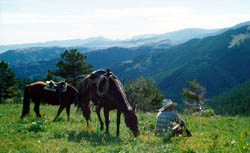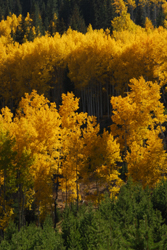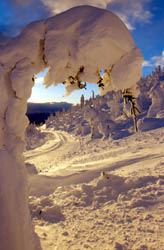Climate Information
Updated: August 10, 2020

After hearing tales of the state’s record temperature extremes and the blustery, bitterly cold winter weather conditions in some parts of the state, some nonresidents may think of Montana as an icebox. Although it can get extremely cold in Montana, due in part to Montana’s northern location, there is a great deal of diversity in state’s weather. In fact, Montana is seldom consistently cold or hot. The state’s low humidity translates into temperatures that are neither oppressively hot nor cold. Average daytime temperatures vary from 28 degrees in January to 84.5 degrees in July.
Montana's eastern and western regions, separated by the Continental Divide, experience different climates. The west tends to have a milder climate than the east, with warmer winters, cooler summers, lighter winds, and rainfall that is more evenly distributed throughout the year. The climate of this side of the Continental Divide is influenced strongly by mild air from the Pacific coast, while the eastern side has harsher continental weather. The eastern side has hotter summers and colder winters than those experienced by the western side. The east, however, also tends to have less humidity and more sunny days on average.
Every season in Montana holds surprises:

Rainfall is generally light, with most falling between May and July. Average rainfall for the western part of the state is 18 inches a year; 13 inches for the east. During July and August brief mid-day thunderstorms are a common, and the heavy downpours cool the late afternoon temperatures. Sometimes these storms are severe such as hailstorms that cause crop and property damage.
By the time September rolls around, the weather becomes cooler. In October beautiful fall colors burst to life across the state and the smell of woodsmoke lingers on the air. Even though frost often covers the ground before the sun gets high enough to chase it away, there is the potential of an Indian summer which brings lovely mild temperatures and big blue skies.

Winters in Montana, while usually cold, have few extended cold spells. Montana's cold spells are frequently interrupted by warm, dry chinook winds that cause mild periods that last for ten days or more. Chinook winds from the eastern Rocky Mountains can bring rapid temperature increases of 40 to 50 degrees Fahrenheit within a few minutes.
Annual snowfall in Montana reach up to 300 inches (25 feet) in the Rocky Mountains in the western half of the state; the east may get as little as 20 inches. Most of the larger cities have annual snowfall within the 30- to 50-inch range. The heaviest snowfall occurs between November and March, but heavy snowstorms can occur as early as mid-September or as late as early May in the higher southwestern part of the state.
In the spring and early summer months when the snow in the mountains begins to melt Montana’s river’s swell with run-off. Heavy rains falling during the spring thaw constitute a serious flood threat. Ice jams during in the rivers during the spring can also cause flooding.
Visit the Western Regional Climate Center's website for a detailed Montana climate summary.
Updated: August 10, 2020

